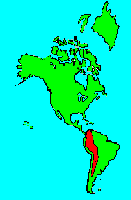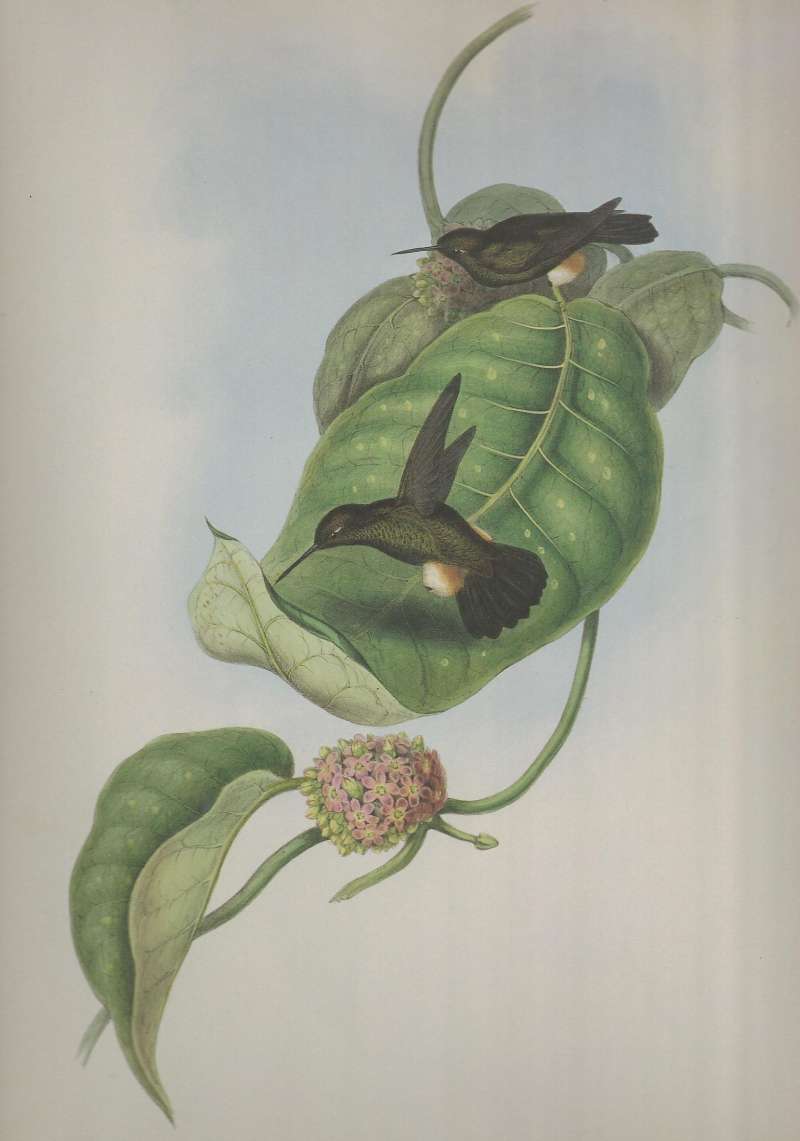SPECIES INFO
Greenish puffleg (Eriocnemis aureliae to Haplophaedia aureliae and to Haplophaedia assimilis) is found from southern Panama south through Ecuador to western Bolivia. This less than 4 inch (9 cm) bird is dorsally greenish brown and the breast is dark green.
A note on different and changing opinions. In the Monroe Sibley checklist of birds published in 1993, they noted two species in the genus: H. aureliae from Panama to western South America, and H. lugens from the Andes of northwestern South America.
In Howard and Moore in 2003, they noted three species in the genus: H. aureliae from Panama south to Ecuador, H. assimilis from Peru to Bolivia, and H. lugens from southwestern Colombia into Ecuador.
In the Collins 2006 Illustrated Checklist (and republished by Princeton), they had two species in the genus. H. aureliae shown on the map as in the Andes from Colombia south to NW Bolivia, and H. lugens, local in the area of Ecuador.
In the Clements list of 2007, we note H. aureliae from Panama to Ecuador, H. assimilis from Peru to western Bolivia, and H. lugens from SW Colombia into Ecuador.
The subspecies of the more limited H. aureliae are as follows: The nominate subspecies H. aureliae aureliae, is found in the eastern Andes of Colombia. The subspecies caucensis is found from Panama south into the central Andes of Colombia. The subspecies russata is found in the eastern Andes in Ecuador, and the subspecies cutucuensis is also found in eastern Ecuador (Cutucu).
John Gould mentioned this specimens came from the Hill Districts of Colombia and also some from Bogota.The puffleg genus (Haplophaedia) is found in the Andes Mountains from Bolivia just into Panama. There are three species. The white feathers on the legs will help in suggesting a genus. These are smaller hummingbirds normally less than 4 inches total length. (The genus Eriocnemis also contains birds named pufflegs.)
We have arbitrarily separated herein a few species of hummingbirds based on their tails of males which include feathers that can be spread into a fan with the feathers of all about the same length. In this group we have placed species where the feathers end in a rounded tip or a very dull point.
Since this feature can be found in several unrelated genera, this division is useful as an aid to identification, but not as an aid to cladistic taxonomy.
Hummingbirds (Family Trochilidae) are a family of 319 species of small birds that are well-known for their ability to hover. Prior to 1900, millions of these birds were exported from South America (primarily Colombia) and the Caribbean for use in jewelry in Europe and England. Many of the species are very brilliantly colored.
This family is nicely represented in Costa Rica where over 50 different species have been recorded.
Swifts and Hummingbirds (Order Apodiformes) are combined into a single order. Both families have excellent flying abilities. The swifts are known for their speed, and the hummingbirds for their ability to hover.
Clements in 2007 listed 100 swifts, 4 treeswifts, and 339 hummingbirds. (Total of 443 species.)
Aves contains about 8,650 different species of living birds known to science. Each year about one new species is discovered in some remote rain forest or remote island. In addition, scientists have been raising many subspecies to full species status which may raise the species count to 10,000. Birdlife recognizes 10,027 species as of 2011.
However, each year about one species goes extinct. The rate of extinction is increasing, and the rate of new discovery is decreasing, so that the number of bird species will soon begin to decline rapidly. Although different taxonomists would organize the birds differently, there are approximately twenty-seven orders of birds. These orders are broken down into about one hundred and fifty-five different families.
Recent research of the genetic structure of some of the shore birds and owls would indicate that the present organization of orders and families should have some modification.
The birds are a worldwide group of animals that are characterized by having the front limbs modified into wings that are used for flying. Perhaps the most unique feature of the birds is the feathers. These feathers are made up of a central support called a quill and a series of small filaments that are hooked together as barbs.
For many years it was believed that Archaeopteryx discovered in Bavaria was the oldest bird from about 150 million years ago. However, in l986, Sankar Chattterjee, a Texas paleontologist, reportedly discovered a bird in the genus Protoavis that lived about 225 million years ago.
When this project was begun in 1978, we used Austin & Singer for bird taxonomy. Since then, we have adopted many changes, but have kept some older concepts that are still found widely in the literature. Recently, we have used Clements and Howard & Moore. Very recently, we have used Monroe and Sibley for the higher taxonomy of the perching birds.
Backboned Animals (Phylum Chordata) are the most advanced group of animals on earth. These animals are characterized by having a spinal cord or backbone. Most members have a clearly defined brain that controls the organism through a spinal cord. Fish, amphibians, reptiles, birds, and mammals are in this phylum.
Currently, some taxonomists believe that the fish should be divided into two groups (sharks and regular fishes) and that there are some other primitive groups in the phylum such as hagfish or lampreys.
Animal Kingdom contains numerous organisms that feed on other animals or plants. Included in the animal kingdom are the lower marine invertebrates such as sponges and corals, the jointed legged animals such as insects and spiders, and the backboned animals such as fish, amphibians, reptiles, birds, and mammals.


